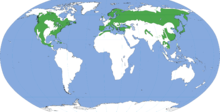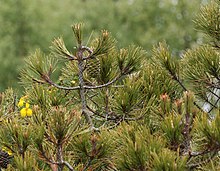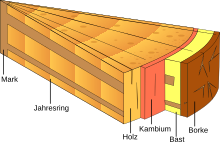Pine trees
| Pine trees | ||||||||||||
|---|---|---|---|---|---|---|---|---|---|---|---|---|
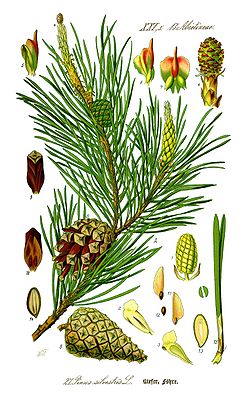
Forest pine ( Pinus sylvestris ), illustration |
||||||||||||
| Systematics | ||||||||||||
|
||||||||||||
| Scientific name of the subfamily | ||||||||||||
| Pinoideae | ||||||||||||
| link | ||||||||||||
| Scientific name of the genus | ||||||||||||
| Pinus | ||||||||||||
| L. |
The pines , Scots or Forlen ( Pinus ) form a genus of plants in the pine family (Pinaceae) within the softwood family (Pinophyta). Pinus is the only genus in the subfamily Pinoideae .
Etymology of common names
With pine related words, in almost all Germanic languages available, for example, English fir (although today the English term for fir is). The word jaw is occupied only from the 16th century and is probably due to contraction of ahd. Kienforha emerged (Kienföhre).
description

Vegetative characteristics
Pinus species are trees or, less often, bushes . The wood, the bark, the leaves shaped as needles and often also the cones form resin channels . The trunk is monopodial , so it goes through from the base to the tip. The branching from the trunk takes place in dummy whorls. The bark is furrowed or divided into plates to thin and scaly or thin and smooth. The shoots are twofold, short and long shoots are distinguished. The seedlings have three to 24 cotyledons .
The buds of the long shoots and cones are initially protected by scale-shaped lower leaves , but not the short shoots and pollen cones . The scale leaves soon fall off or remain on the branches.
The needles rarely grow individually or in bundles, usually in pairs, up to five and sometimes up to eight together, which are surrounded by a needle sheath at the base. The needle sheath soon falls off or remains on the tree. The needles stay on the tree for two to 30 years and fall off as a bundle. They reach lengths of 2.5 to 50 centimeters and are usually 0.5 to 2.5 (with one species up to 7) millimeters thick. They are needle-shaped or, in one species, lanceolate, plan-convex or triangular in cross-section, less often pedicel-round or flat. The edge is whole or finely sawn. The stomata lie on all sides of the leaves, only on the upper side or sometimes only on the underside of one species.
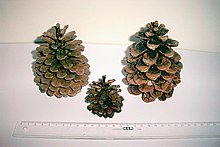
Generative characteristics
Pinus species are single sexed ( monoecious ). The pollen cones grow in a spiral near the base of young long shoots. They are ovate-oblong to cylindrical and consist of a thin axis with numerous, spirally arranged, more or less shield-shaped microsporophylls .
The seed cones are stalked and stand individually or more often in groups near the ends of the shoots. They are obliquely ovate, ovate to cylindrical and 2 to 60 centimeters long. They usually ripen after two or less often after three years, are soon thrown off or remain on the tree for longer. They grow erect at first and are pendulous or protruding when ripe. The cover scales are inconspicuous during pollination and do not continue to grow like the seed scales. The seed scales are permanent, obovate to oblong, thin or thick woody and spirally connected with a thin or thick central axis. The part of the scale that is visible when closed is called the apophysis and is thickened and / or lengthened to various degrees. The apophysis has a dorsal or terminal umbo that can be armed with a spike.
The seeds are usually somewhat flattened and have an overgrown or articulated, membranous wing that is formed from the adaxial part of the seed scales. It can be several times longer than the seed or it can also recede.
Distribution and cultivation
Pine species are mainly native to the northern hemisphere . The main areas of distribution are cool, humid climatic areas. However, many species also colonize subtropical and tropical areas.
Pine trees are now grown worldwide in suitable climatic zones. In Korea and Japan in particular, the pines have a special symbolic meaning: there they stand for strength, longevity and constant patience. In these countries, pines are therefore particularly often found in carefully designed form in temples and gardens.
Pines are the most important tree species in forestry worldwide. Mostly undemanding and vigorous, they are often used in place of the native tree species for effective reforestation after forest destruction and clearing. In the tropics and subtropics, pines are grown in wood plantations. There are also large areas of pine trees in the Mediterranean region and in Japan. In Central Europe , large areas of forest were reforested with the Scots pine in monoculture far beyond their natural occurrence . Although these pure stands are easy to establish and harvest, they are much more susceptible to forest fires and insect infestation than more natural mixed forests; In the medium term they therefore lead to leaching and acidification of the soil.
Systematics
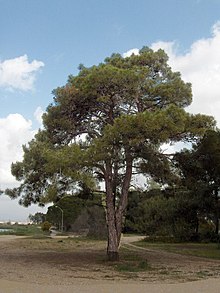







Inyo National Forest , California (USA)



Taxonomy
The genus Pinus was established by Carl von Linné in 1753 . The generic name Pinus was already used by the Romans for several types of pine. Synonyms for Pinus L. are: Apinus Neck. ex Rydb. , Caryopitys Small , Ducampopinus A. Chev. , Leucopitys Nieuwl. , Pinea Wolf , Strobus Opiz .
External system
Pinus is the only genus of the subfamily Pinoideae Link , which was established in 1831 by Heinrich Friedrich Link in Handbuch , 2, Seite 476.
Internal system
The classic division of the genus into three sub-genera was reduced to two sub-genera on the basis of molecular genetic studies. According to Aljos Farjon 2010, the genus Pinus contains around 113 species, which are structured as follows:
Subgenus Pinus (Diploxylon): It occurs in Eurasia , North Africa , eastern North America and Cuba:
- Section Pinus :
- Pinaster subsection : It occurs in the Canary Islands, the Mediterranean and the Himalayas.
- Calabrian pine ( Pinus brutia Ten. )
- Canary pine ( Pinus canariensis C.Sm. )
- Aleppo pine ( Pinus halepensis Mill. )
- Snake skin pine ( Pinus heldreichii H.Christ )
- Pinus latteri Mason
- Pinus merkusii Jungh. & de Vriese : It occurs in the Philippines and Sumatra .
- Maritime pine ( pinus pinaster aiton )
- Pine ( Pinus pinea L. )
- Pinus roxburghii coffin.
- Subsection Pinus : Their distribution area corresponds to that of the subgenus.
- Pinus densata mast.
- Japanese red pine ( Pinus densiflora Sieb. & Zucc. )
- Pinus hwangshanensis W.Y.Hsia
- Pinus kesiya Royle ex Gordon : Its range includes South and Southeast Asia from India to the Philippines.
- Pinus luchuensis Mayr
- Pinus henryi mast.
- Pinus massoniana Lamb.
- Mountain pine ( Pinus mugo turra )
- Black pine ( Pinus nigra J.F. Arnold )
- American red pine ( Pinus resinosa Aiton )
- Forest pine ( Pinus sylvestris L. )
- Chinese pine ( Pinus tabuliformis Carrière )
- Pinus Taiwanensis Hayata
- Japanese black pine ( Pinus thunbergii Parl. )
- Pinus tropicalis Morelet
- Spirke , Haken-Kiefer, upright mountain pine ( Pinus uncinata Ramond ex DC. , Syn .: Pinus mugo subsp. Uncinata (Ramond) Domin )
- Pinus yunnanensis Franch.
- Pinaster subsection : It occurs in the Canary Islands, the Mediterranean and the Himalayas.
- Section Trifoliae : It occurs from North America via Mexico to the Caribbean Islands.
- Subsection Contortae : It occurs in North America:
- Banks pine ( Pinus banksiana Lamb. )
- Sand pine ( Pinus clausa (Chapm. Ex Engelm.) Vasey ex coffin. )
- Coastal pine ( Pinus contorta douglas ex loudon )
- Pinus virginiana Mill.
- Subsection Ponderosae : It occurs from the western USA via Mexico to Central America .
- Pinus arizonica Engelm.
- Coulter pine ( Pinus coulteri D.Don )
- Pinus devoniana Lindl.
- Pinus douglasiana Martínez
- Pinus durangensis Martínez
- Pinus engelmannii Carrière
- Pinus hartwegii Lindl.
- Jeffrey pine ( Pinus jeffreyi A. Murray )
- Pinus maximinoi H.E. Moore
- Montezuma pine ( Pinus montezumae Lamb. )
- Yellow pine ( Pinus ponderosa Douglas ex C.Lawson ): The three subspecies occur from southern British Columbia , via southwestern North Dakota to Texas and California to Mexico only in Baja California and Sonora .
- Pinus pseudostrobus Lindl. : with three varieties from Mexico over the highlands of Guatemala to northern El Salvador and western Honduras .
- White pine ( Pinus sabiniana Douglas )
- Pinus torreyana Parry ex Carrière
- Australes subsection : It occurs from North to Central America and on the Caribbean islands.
- Pinus attenuata Lemmon
- Caribbean pine ( Pinus caribaea Morelet ): It comes with three varieties in the Bahamas and Turks and Caicos Islands (var. Bahamensis ), in western Cuba in the province of Pinar del Río and on the Isla de la Juventud (var. Caribaea ) and from Mexican state of southern Quintana Roo over northern Guatemala to Belize and Honduras including the Islas de la Bahía to El Salvador and Nicaragua .
- Cuban pine ( Pinus cubensis Griseb. ): It occurs in eastern Cuba, for example in the Sierra Maestra and Sierra de Nipe.
- Pinus echinata Mill.
- Pinus elliottii Engelm.
- Pinus glabra Walter
- Pinus greggii Engelm. ex Parl.
- Pinus herrerae Martínez
- Pinus jaliscana Perez de la Rosa
- Pinus lawsonii Roezl ex Gordon
- Pinus leiophylla Schiede ex Schltdl. & Cham.
- Pinus lumholtzii B.L.Rob. & Fernald
- Pinus luzmariae Pérez de la Rosa
- Episcopal pine ( Pinus muricata D.Don )
- Pinus occidentalis Sw. : It occurs only on Hispaniola at altitudes between 200 and 3200 meters.
- Pinus oocarpa Schiede
- Swamp pine ( Pinus palustris Mill. )
- Pinus patula Schiede ex Schltdl. & Cham.
- Pinus praetermissa Styles & McVaugh
- Pinus pringlei Shaw
- Pinus pungens Lamb.
- Monterey pine ( Pinus radiata D.Don ): The natural range extends from California to Baja California and offshore islands. It is a forest tree in many countries around the world.
- Pitch pine ( Pinus rigida Mill. )
- Pinus serotina Michx.
- Frankincense Pine ( Pinus taeda L. )
- Pinus tecunumanii F.Schwerdtf. ex Eguiluz & JPPerry
- Pinus teocote var. ex Schltdl. & Cham.
- Subsection Contortae : It occurs in North America:
Subgenus Strobus (Haploxylon):
- Section Parrya : It occurs from the western USA to Mexico:
- Subsection Balfourianae : It occurs in the western United States.
- Awn pine ( Pinus aristata Engelm. )
- Foxtail pine ( Pinus balfouriana Balf. )
- Long-lived pine ( Pinus longaeva D.K.Bailey )
- Subsection Cembroides : It occurs in the southwestern United States and Mexico.
- Pinus cembroides Zucc.
- Pinus culminicola Andresen & Beaman
- Pinus edulis Engelm.
- Single-leaved pine ( Pinus monophylla Torr. & Frém. )
- Pinus quadrifolia Parl. Ex Sudw.
- Pinus remota (Little) DKBailey & Hawksw.
- Subsection Nelsoniae Burgh : It occurs in Mexico.
- Pinus nelsonii Shaw
- Subsection Rzedowskianae :
- Pinus rzedowskii Madrigal & M.Caball.
- Pinus maximartinezii Rzed.
- Pinus pinceana Gordon
- Subsection Balfourianae : It occurs in the western United States.
- Section Quinquefoliae : It occurs in eastern Asia and in North America to Mexico:
- Subsection Gerardianae : It occurs in East Asia and in the Himalayas:
- Bunges pine ( Pinus bungeana Zucc. Ex Endl. )
- Pinus gerardiana Wall. ex D.Don
- Pinus squamata X.W.Li
- Subsection Krempfianae : It occurs in Vietnam.
- Pinus krempfii Lecomte
- Strobus subsection : It occurs in North America and Eurasia.
- White-stemmed pine ( Pinus albicaulis Engelm. )
- Pinus amamiana Koidz.
- Armands Pine ( Pinus armandii Franch. ): The three varieties occur in central to western China, in Taiwan and in northern Myanmar .
- Mexican white pine ( Pinus ayacahuite Ehrenb. Ex Schltdl. )
- Pinus bhutanica Grierson, DGLong & CNPage
- Swiss stone pine ( Pinus cembra L. )
- Pinus dalatensis Ferré
- Pinus fenzeliana Hand.-Mazz.
- Flexible Pine ( Pinus flexilis E. James )
- Korean pine ( Pinus koraiensis Sieb. & Zucc. )
- Sugar Pine ( Pinus lambertiana Douglas )
- Western white pine ( Pinus monticola Douglas ex D.Don )
- Pinus morrisonicola Hayata
- Maiden Pine ( Pinus parviflora Sieb. & Zucc. )
- Rumelian pine ( Pinus peuce Griseb. )
- Dwarf pine ( Pinus pumila (Pall.) Regel )
- Siberian stone pine ( Pinus sibirica Du Tour )
- Pinus strobiformis Engelm.
- White Pine ( Pinus strobus L. )
- Lacrimal pine ( Pinus wallichiana A.B. Jacks. ): It occurs in the southern Himalayas from Afghanistan via Pakistan and India, Nepal and Bhutan to Myanmar and Tibet .
- Pinus wangii Hu & WCCheng : It occurs in southeastern Yunnan only in Malipo and Xichou , maybe also in Vietnam.
- Subsection Gerardianae : It occurs in East Asia and in the Himalayas:
Diseases
- Blue stain (various pathogens such as Ceratocystis and Ophiostoma piliferum ): This is a discoloration of the wood.
- Pine bark blister rust ( Cronartium flaccidum or Endocronartium pini ): A rust fungus that leads to the formation of the Kienopf.
- Straw rust ( Cronartium ribicola ): Affects five-needle pines.
- White snow mold ( Phacidium infestans ): Affects the stone pine .
- Black snow mold ( Herpotrichia coulteri ): attacks the mountain pine .
use
Along with spruce, pine is one of the most important softwoods. As with the other species, the decisive factors are the straight growth, the rapid growth, the low demands on the location and the good usability of the wood. The mechanical properties of the wood are very good compared to those of the spruce, but at the same time the range is very large and depends on the origin and the growth conditions of the pine.
The range of applications includes, above all, its use as construction and furniture wood for indoor use as well as its use as firewood . Pine wood is processed in the form of round timber , sawn timber such as boards and glued laminated timber and as veneer wood . At the same time, it is an important wood for the manufacture of chipboard . Pine wood is used almost everywhere as building and construction timber, both in interior construction and in exterior applications. It is used accordingly in house construction for roof structures, for wood paneling, railings, stairs, skeleton structures for walls and ceilings, floors, windows, doors and gates. Impregnated pine wood is used as facade cladding, terrace decking and other applications such as children's play equipment, fences, pergolas and others in gardening and landscaping. In addition, there are a number of other uses such as masts, posts, piles and other outdoor applications, especially as driven piles in water engineering, port construction and mining, and pine wood is also popular as a sleeper in the track construction of subways and works trains.
Pines are also used to extract resin and pitch . The resinous sapwood that forms the pine around injuries was previously used as pine wood for lighting.
The seeds of individual pine species are so large that they are used as food ( pine nuts , " cedar nuts ").
symbolism
In China , the pine is a symbol of longevity, durability and self-discipline. The paired appearance of the needles represents the happy togetherness of the marriage. Together with plum and bamboo, it is one of the three friends of winter .
The US state of Maine is nicknamed "The Pine Tree State" and uses the pine tree as a symbol in its flag and seal .
literature
- Aljos Farjon: A Handbook of the World's Conifers . tape 2 . Brill, Leiden-Boston 2010, ISBN 978-90-04-17718-5 , pp. 608, 609 .
- Christopher J. Earle: Pinus. In: The Gymnosperm Database. May 22, 2011, accessed on November 12, 2011 (English, section description, distribution and systematics).
- Robert Kral: Pinus . In: Flora of North America Editorial Committee (Ed.): Flora of North America North of Mexico . Volume 2: Pteridophytes and Gymnosperms . Oxford University Press, New York / Oxford a. a. 1993, ISBN 0-19-508242-7 , pp. 373–398 (English, limited preview in Google Book Search).
Individual evidence
- ↑ Leo
- ↑ See information on the origin of pine at Duden online .
- ↑ a b c d e f g Aljos Farjon: A Handbook of the World's Conifers. Volume 2, p. 608
- ↑ a b Pinus at Tropicos.org. Missouri Botanical Garden, St. Louis, Retrieved April 20, 2019.
- ↑ Helmut Genaust: Etymological dictionary of botanical plant names. 3rd, completely revised and expanded edition. Birkhäuser, Basel / Boston / Berlin 1996, ISBN 3-7643-2390-6 , p. 487.
- ↑ David S. Gernandt, Gretel Geada López, Sol Ortiz García, Aaron Liston: Phylogeny and classification of Pinus. In: Taxon. Volume 54, No. 1, 2005, pp. 29-42, PDF file, 442 kB. ( Memento from August 24, 2007 in the Internet Archive )
- ^ Aljos Farjon: A Handbook of the World's Conifers. Volume 2, p. 609
Web links
- Pinus. In: Mineralienatlas. Stefan Schorn, accessed on November 12, 2011 (images of fossil pines).
